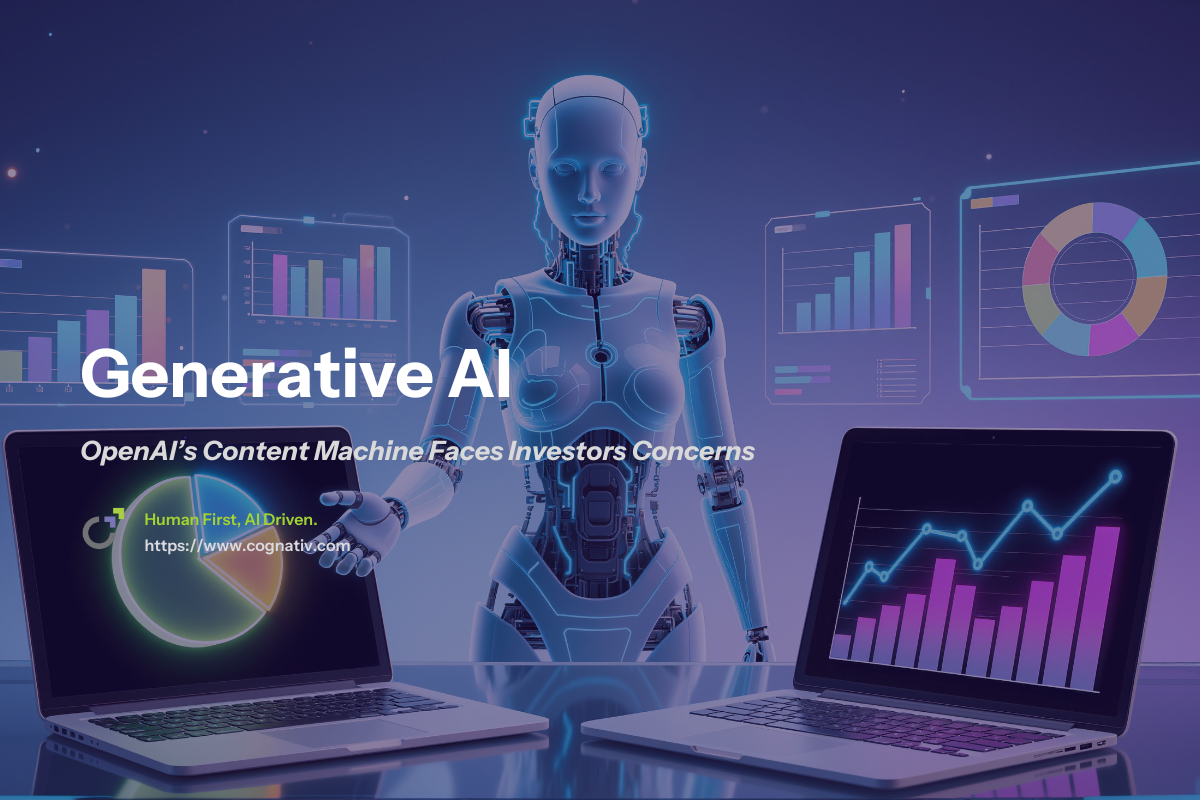

Tuesday, October 28, 2025
Kevin Anderson
OpenAI’s Content Machine Faces Investors Concerns
OpenAI CEO Sam Altman has been at the forefront of the AI boom, driving the company’s rapid rise in market value and user base. However, beneath the surface of viral AI products and widespread consumer adoption lies a daunting corporate challenge. Maintaining investor confidence while managing the high costs of production and sustaining revenue streams is a complex balancing act.
OpenAI’s hype machine—fueled by innovative AI products like Sora—has captured the imagination of millions worldwide. Yet, as the AI bubble bursts and the initial excitement levels off, the company must prove its ability to deliver consistent value to businesses and enterprise customers. The question is no longer just about being the first to market but about building software and AI agents that provide tangible benefits and a clear return on investment.
“The AI boom has ignited unprecedented interest, but the real test for OpenAI and other AI companies is how well they can convert hype into sustainable business models.”
— Industry Analyst, Bloomberg Finance

The Cost of Innovation and Operating at Scale
One significant challenge OpenAI faces is managing the enormous cost associated with running advanced AI models. Each query processed by their AI agents requires substantial computational power, which translates into high operating expenses. While many users enjoy free or low-cost access, the company’s revenue depends heavily on paid subscriptions and enterprise contracts.
This cost dynamic creates pressure to innovate rapidly while controlling expenses. The company must also compete with other AI companies, including Google and Facebook, which are investing heavily in their own AI products and services. As the AI bubble bursts for some, OpenAI’s ability to maintain an edge in technology and market share will be critical.

Corporate Reality Check: Winning Over Businesses
Successfully transitioning from consumer popularity to enterprise trust requires OpenAI to address the unique demands and expectations of corporate clients.
Building Products for Enterprise Success
OpenAI’s initial success was largely consumer-driven, with millions of users engaging with ChatGPT and related tools. However, the corporate challenge lies in winning over businesses that demand reliability, security, and compliance. Enterprise customers require AI solutions that integrate seamlessly with existing software and provide measurable improvements in efficiency and decision-making.
Securing contracts with major corporations is a key milestone. These contracts often come with higher price points and longer-term commitments, providing more stable revenue streams. OpenAI’s ability to demonstrate that its AI agents can reduce costs, accelerate workflows, and improve customer service will be essential to winning these deals.
The Role of AI Agents in Business Operations
AI agents are becoming integral to many industries, from customer support chatbots to automated code review systems. OpenAI’s development of agentic AI—where AI systems can autonomously perform complex tasks—is a promising avenue to differentiate itself from competitors. These agents can handle repetitive queries, analyze large datasets, and provide intelligent recommendations, making them valuable tools for businesses.
“AI agents represent the next frontier in AI adoption, moving beyond simple chatbots to sophisticated software that can operate with minimal human intervention.”
— Tech Lead, San Francisco AI Hub

Market Dynamics: Competition and Collaboration
In this fast-evolving world of generative AI, making sense of market shifts and developing strong partnerships is a key matter for any AI company aiming to stay ahead.
The Competitive Landscape
The AI market is evolving rapidly, with several players vying for dominance. OpenAI’s competitors include not only tech giants like Google and Facebook but also specialized startups like Anthropic and Cohere. These companies are exploring different business models, such as on-premises AI deployment for enhanced security or cost-saving innovations in AI query processing.
A recent survey of enterprise IT decision-makers revealed a shift in market share, with OpenAI’s lead shrinking as competitors gain traction. This trend underscores the importance of continuous innovation and strategic partnerships.
Company |
Estimated Market Share (2024) |
Key Differentiator |
|---|---|---|
34% |
Cutting-edge AI models, broad adoption | |
Anthropic |
24% |
Cost-efficient AI agents, coding focus |
14% |
Integration with existing cloud services | |
Cohere |
8% |
Collaboration with Industry Leaders
Strategic collaborations are another way OpenAI aims to strengthen its position. Partnerships with companies like Microsoft and Apple provide access to vast resources and customer bases. These alliances also help OpenAI integrate its AI products into widely used platforms, increasing user engagement and enterprise adoption.

Financial Outlook: Funding, Revenue, and Investor Confidence
As OpenAI’s hype machine faces a corporate challenge, the company must also head into the daunting challenges of managing money, funding, and market value to maintain investor confidence and keep the conversation positive in every post and message.
Funding and Market Value
OpenAI’s market value has soared to an estimated $157 billion, fueled by substantial funding rounds and a growing user base. However, this valuation is largely based on future growth expectations rather than current profitability. The company’s revenue, estimated at around $12 billion annually, reflects strong growth but also highlights the gap between hype and sustainable earnings.
The Importance of Revenue Growth and Cost Control
Investors are closely watching OpenAI’s ability to convert its popularity into steady revenue growth. The company’s subscription model, enterprise contracts, and API usage fees are vital revenue streams. Yet, controlling the costs of operating AI models remains a significant challenge.
“The story behind OpenAI’s valuation is compelling, but the real test will be its ability to build a profitable business that delivers value to both consumers and enterprises.”
— Financial Analyst, New York

Looking Ahead: The Future of OpenAI and the AI Industry
As the president and co founder of OpenAI, Sam Altman continues to lead the company through a pivotal week in AI development, setting the stage for the next phase of growth and innovation.
Embracing the Next Decade of AI Innovation
The AI industry is expected to generate over $1 trillion in revenue within the next decade. OpenAI’s challenge is to maintain its technological edge and expand its footprint across various sectors, including healthcare, fintech, and telecom. By focusing on AI-first architecture and integrating AI/ML capabilities into custom software, OpenAI can help businesses modernize legacy systems and improve operational efficiency.
Signs of Change and the Path Forward
As the initial hype settles, the AI landscape is entering a more mature phase. Companies that can demonstrate clear business value and operational excellence will win. OpenAI’s ability to adapt, innovate, and build strong corporate relationships will determine whether its hype machine translates into long-term success.
“The moment has come for AI companies to prove their worth beyond the buzz. OpenAI’s journey is a prime example of this transition from hype to reality.”
— Industry Commentator, House of AI
OpenAI’s hype machine faces a corporate challenge that is as much about technology as it is about business strategy. The company must navigate a complex market, manage costs, and deliver AI products that meet the evolving needs of both consumers and enterprises. With competition rising and the AI bubble showing signs of bursting, OpenAI’s future depends on its ability to win over businesses, secure funding, and maintain investor confidence in a rapidly changing landscape.

